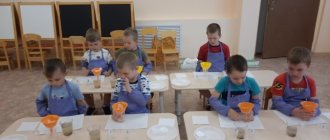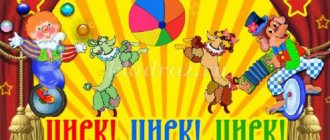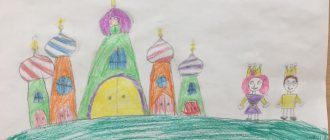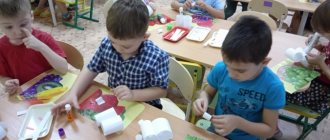Integrated and comprehensive classes
Integrated learning allows you to see and understand any phenomenon holistically; in kindergarten there is a subject-based learning system and it often turns out that knowledge remains scattered, artificially divided according to the subject principle, and as a result, children do not always holistically perceive the whole picture of the world around them.
Integrated classes are a combination of several types of activities. Complex classes within the framework of one topic solve different problems of children's development and are based on different types of activities. These classes can be carried out in all age groups, but they are especially useful with older preschoolers.
The section of the site, integrated and comprehensive classes in kindergarten for different groups, contains many interesting publications for educators on teaching children on various topics:
- Scenario for an integrated lesson in kindergarten
- Integrated lesson on application and ecology in kindergarten
- Summary of an integrated educational activity in kindergarten with children 3-4 years old
- Summary of an integrated educational activity with children 2–3 years old in kindergarten
- Lesson summary for younger children integrated lesson in junior group 2
- Synopsis of the integrated GCD preparatory group of kindergarten
- Summary of GCD in kindergarten
- Summary of an integrated lesson in the middle group of kindergarten
- Summary of an integrated lesson for Victory Day in kindergarten
- Summary of an integrated lesson in kindergarten with children of senior preschool age
- Summary of integrated organized educational activities
- Summary of an integrated lesson on cognitive-speech and artistic-aesthetic development of children in the second junior
- Integrated lesson in the preparatory group
- Summary of an integrated lesson on the Russian language and the surrounding world for a preparatory school group
- Integrated open lesson with children of the preparatory group
- Summary of an integrated lesson for the middle group of kindergarten
- Integrated open lesson
- Integrated lesson for the middle group
- Open integrated lesson on speech development, the environment and mathematics in the preparatory group of kindergarten
- Summary of an integrated lesson on ecology and speech development, senior mixed-age group
- Summary of integrated OOD in the senior group
- Summary of integrated OOD in the preparatory group
- Summary of an integrated lesson in kindergarten
- Summary of the final integrated lesson in the first junior group
The most important thing in integrated classes in a preschool educational institution is the unity of goals, understanding of the techniques, methods, tasks that determine the harmonious development of the child’s personality, in other words, the ability to “crawl”, “enter” the pedagogical process, without creating stress for children, literally physically reducing to level of their eyes and focusing, in organizing their work, on their right-hemisphere characteristics. A fundamentally important point in organizing integrated classes in preschool educational institutions will be the activation of all mental processes that ensure successful learning.
The modern direction of development of the educational system has affected all kindergartens in the country without exception. Now integrated classes in preschool educational institutions are considered popular and most effective. The Ministry of Education approves and encourages the comprehensive development of students, as evidenced by a number of recommendations from the Federal State Educational Standard. What are integrated classes? In general, training according to a similar principle involves the simultaneous development of the child.
Integrated lesson in kindergarten - combines knowledge from various educational fields, on an equal basis, complementing each other (for example: the concept of “autumn” is considered through the means of music, art, painting, ecology). At the same time, in such a lesson, the teacher solves several development problems.
An integrated lesson is an activity that is aimed at revealing the holistic essence of a certain topic through different types of activities, which are combined in the broad information field of the lesson through mutual penetration and enrichment.
SPECIFICITY OF INTEGRATED CLASSES IN KINDERGARTEN article (senior group) on the topic
SPECIFICITY OF INTEGRATED
CLASSES IN KINDERGARTEN
Educator
Atemarsky d/s
"Teremok"
Glazkova I.V.
In recent years, the need for effective methods of raising children has noticeably increased, for the organization of a comprehensive and integrated educational activity (Direct Educational Activity). The Law on Education has provided teaching staff with the opportunity to choose educational programs. But no matter what program the kindergarten chooses, the content of preschool education should be aimed at solving the following tasks:
· maintaining the health of the child;
· development of creative abilities;
· formation of a holistic perception of the surrounding world;
· building an educational process based on play as the main activity of a preschooler.
The purpose of integrated classes is: a comprehensive, conscious study of the concept; objects or phenomena through a combination of activities - creative, artistic, playful - accessible to children of this age.
Any kindergarten program is focused on the holistic development of the child, which should be understood as the unity of individual abilities and personal qualities. The integrated learning system makes it possible to maintain the number of classes, free up time for independent and play activities, and increase the time allotted for walks.
Integrated learning is a new model aimed at the potential development of personality, student-centered learning and education of children, taking into account their inclinations and abilities.
The integrated approach meets one of the main requirements of preschool didactics: education should be small in volume, but capacious.
Integrated classes arouse interest and help relieve stress, overload and fatigue by switching them to a variety of activities.
The most effective methods and techniques
· Comparative analysis, comparison, search.
· Problematic questions, the use of tasks such as “prove”, “explain”, “how did you know?” and etc.
· A variety of speech didactic games to familiarize yourself with cultural and speech standards, activate your vocabulary, and cultivate a sense of self-confidence.
Requirements for the structure of integrated classes:
· Clarity, compactness, conciseness of educational material.
· Thoughtfulness and logical interrelation of the studied material of the program sections in each lesson.
· Interdependence, interconnectedness of subjects at each stage of classes.
· Large information capacity of educational material used in the lesson.
· Systematic and accessible presentation of the material.
· The need to adhere to the time frame of the lesson.
Sample lesson structure
Introductory part: A problematic situation is created that stimulates the activity of children to find a solution (for example, the question is asked “Guys, what will happen if there is no water on Earth?”)
Main part: Children are given new tasks necessary to solve a problematic issue (for example, the importance of water in nature and human life, etc.) based on the content of different sections of the program based on visualization; in parallel, work is going on to enrich and activate the vocabulary, training coherent speech.
Final part: Children are offered any practical work (didactic games, drawing, etc.) to consolidate the information received or update previously learned information. .
Characteristics of an integrated lesson
· Is one of the areas of interdisciplinary integration.
· Has a medium degree of integration.
· The form has a mixed structure.
· The subject of analysis is multifaceted objects; the independence of each section with its own goals, objectives, and program is preserved.
Pedagogical possibilities of an integrated lesson:
· Formation of knowledge and skills in unity.
· Communication skills.
· Increasing interest in learning.
· Relieving tension, fear, uncertainty.
Advantages of integrated classes:
· contribute to increasing the motivation of learning, the formation of cognitive interest of students, a holistic picture of the world and consideration of the phenomenon from several sides;
· to a greater extent than regular classes, they contribute to the development of speech, the formation of students’ ability to compare, generalize, and draw conclusions, relieve stress and overload;
· deepen the understanding of the concept, the laws associated with the concept, broaden their horizons;
· develop children emotionally, because based on elements of music, painting, literature, plastic movement, etc.
The pedagogical and methodological technology of integrated classes may be different, but in any case their modeling is necessary. Independent search for new optimal schemes-models is a manifestation of the creative activity of the teacher.
Methodology for preparing an integrated lesson
· Identify areas of knowledge, the integration of which is advisable and will contribute to the child’s creation of a holistic understanding of the object of study.
· Analyze and select from these areas the content whose integration is most important.
· Take into account program requirements and age characteristics of preschool children.
· Determine one or more basic areas of integration. Identify the basic principle of building a system of integrated classes.
· Think through developmental tasks.
· Use a variety of activities (for example, dramatizing a fairy tale with construction from building material, musical arrangement and introducing nominative vocabulary into children’s active speech).
· Use a large amount of various visual and attribute materials (demonstration, handouts, games).
· Use productive techniques when working with children (problem situations, logical tasks, experimentation, modeling).
Taking into account conditions when planning and organizing integrated classes
· Mandatory consideration of the content of the basic kindergarten program.
· An integrated lesson combines blocks of various subjects.
· When planning, a careful selection of the type and structure of the lesson, teaching methods and means, and determination of the optimal load with various types of children’s activities in the lesson are required.
· Integration helps relieve tension, overload, and fatigue of children by switching them to various types of activities during the lesson.
· It is necessary to maintain a positive emotional style of relationships between adults and children in the classroom, taking into account the age, individual and psychological characteristics of the children in the group.
· In integrated classes, it is advisable to use a variety of didactic games, developmental exercises, complex tasks, assignments, etc.
Specifics of the analysis
Object of integration (culture, science, local history, people, technology, etc.)
The direction and scope of the integrated sections, in what way it is expressed::
— in creating a new section (program);
— a cycle (block) of periodically repeated classes;
- single integrative classes.
The topic of the integrated lesson, the problem posed for children, the goal. Level of novelty. Has systematization of students’ knowledge been achieved?
Activities of teachers and students in preparation for an integrated lesson.
Forms of implementation.
Number of teachers participating in an integrated lesson. Implementation of cooperation between teachers at an integrated level. A unified approach to the problems and content of the lesson they conducted.
Results of children's activities in integrated classes.
Working in this direction, we can draw some conclusions:
1. Integrated classes contribute to the formation of a picture of the world, since an object or phenomenon is considered from different sides: theoretical and practical;
2. Children develop cognitive interest, and classes give high results;
3. The transition from one type of activity to another allows you to involve each child in an active process;
4. Integrated classes unite children with common impressions, experiences, and contribute to the formation of collective relationships;
5. Such nodes contribute to closer contact between all specialists and cooperation with parents, as a result of which a child-adult community is formed;
6. Integration helps reduce the number of classes, free up time for play activities and walks, which helps improve children's health.
Thus, integrated activities not only enrich children’s knowledge about the world around them, but also contribute to the development of creative thinking, form bright positive emotions in children in the process of their creative interaction and active communication with adults.
Knowing the integrated mechanisms, the teacher can connect different types of activities and create a model diagram of the lesson. Integrated classes arouse interest, help relieve stress, overload and fatigue by switching them to a variety of activities.







